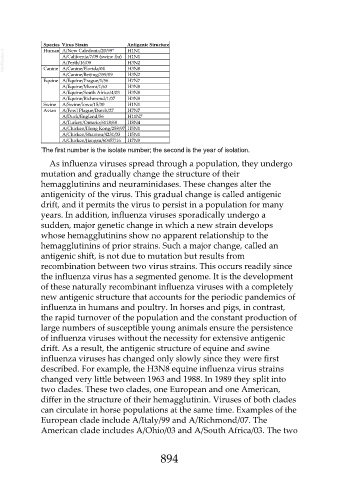Page 894 - Veterinary Immunology, 10th Edition
P. 894
Species Virus Strain Antigenic Structure
VetBooks.ir A/California/7/09 (swine flu) H1N1
Human A/New Caledonia/20/99*
H1N1
A/Perth/16/09
H3N2
Canine A/Canine/Florida/04
A/Canine/Beijing/359/09 H3N8
H3N2
Equine A/Equine/Prague/1/56 H7N7
A/Equine/Miami/1/63 H3N8
A/Equine/South Africa/4/03 H3N8
A/Equine/Richmond/1/07 H3N8
Swine A/Swine/Iowa/15/30 H1N1
Avian A/Fowl Plague/Dutch/27 H7N7
A/Duck/England/56 H11N7
A/Turkey/Ontario/6118/68 H8N4
A/Chicken/Hong Kong/258/97 H5N1
A/Chicken/Shantou/4231/03 H5N1
A/Chicken/Jiangsu/60457/16 H7N9
*
The first number is the isolate number; the second is the year of isolation.
As influenza viruses spread through a population, they undergo
mutation and gradually change the structure of their
hemagglutinins and neuraminidases. These changes alter the
antigenicity of the virus. This gradual change is called antigenic
drift, and it permits the virus to persist in a population for many
years. In addition, influenza viruses sporadically undergo a
sudden, major genetic change in which a new strain develops
whose hemagglutinins show no apparent relationship to the
hemagglutinins of prior strains. Such a major change, called an
antigenic shift, is not due to mutation but results from
recombination between two virus strains. This occurs readily since
the influenza virus has a segmented genome. It is the development
of these naturally recombinant influenza viruses with a completely
new antigenic structure that accounts for the periodic pandemics of
influenza in humans and poultry. In horses and pigs, in contrast,
the rapid turnover of the population and the constant production of
large numbers of susceptible young animals ensure the persistence
of influenza viruses without the necessity for extensive antigenic
drift. As a result, the antigenic structure of equine and swine
influenza viruses has changed only slowly since they were first
described. For example, the H3N8 equine influenza virus strains
changed very little between 1963 and 1988. In 1989 they split into
two clades. These two clades, one European and one American,
differ in the structure of their hemagglutinin. Viruses of both clades
can circulate in horse populations at the same time. Examples of the
European clade include A/Italy/99 and A/Richmond/07. The
American clade includes A/Ohio/03 and A/South Africa/03. The two
894

